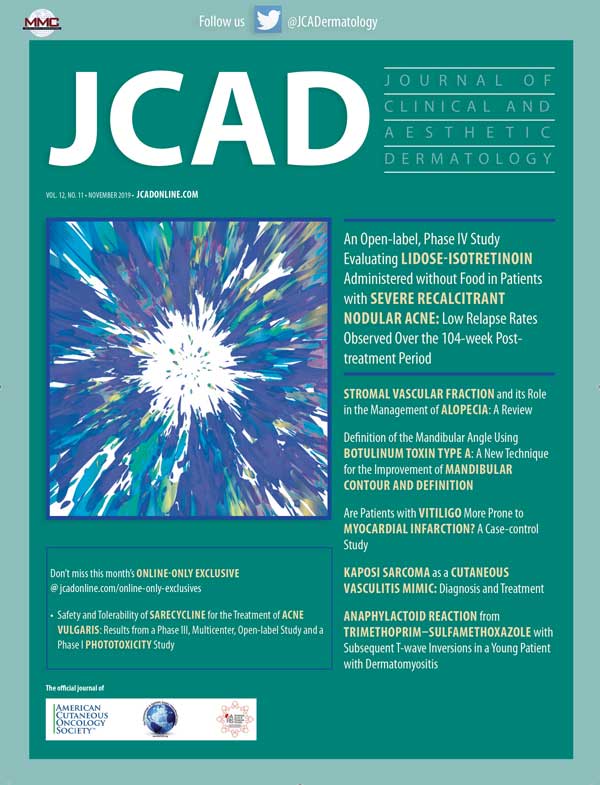VOL. 12, NO. 11 • NOVEMBER 2019
Dear Colleagues:
Welcome to the November 2019 issue of The Journal of Clinical and Aesthetic Dermatology. We begin the issue with results from an , which evaluated long-term relapse rates following lidose-isotretinoin taken without food in patients with severe recalcitrant acne. In this single-arm, open-label study, 197 patients received twice-daily lidose-isotretinoin without food for up to 20 weeks. Patients with a 75-percent or higher adherence rate with the protocol-designated dosage and end-of-treatment lesion counts were predefined as the per-protocol (PP) population and evaluated in a 104-week post-treatment period (PTP) to determine the proportion of patients requiring retreatment. Patients were observed and retreated with isotretinoin or other acne therapy during the PTP, if required. Lesion counts and assessments of acne severity, quality of life, and adverse events were completed. Ultimately, long-term relapse rates for lidose-isotretinoin taken without food for 20 weeks were at the low end of published rates for traditional isotretinoin taken with a high-fat/high-calorie meal.
Next, in a case report by Swali and Lee, the authors present a case of a 19-year-old man with dermatomyositis, whose disease was not complicated with cardiac involvement, yet ultimately showed lasting cardiovascular effects from an anaphylactoid reaction. Upon diagnosis of dermatomyositis, his vital signs were normal, he denied experiencing chest pain, and the electrocardiography findings were unremarkable. However, when the patient later presented to the emergency department in anaphylactic shock, he was hypotensive with a persistently abnormal electrocardiogram. This case, the authors explain, highlights the potential risk for adverse cardiac effects and inflammatory cardiomyopathies, such as dermatomyositis and anaphylaxis.
After this, we present a case report by Yaqub et al, which describes a patient who developed painful, vasculitis-like purpuric lesions that progressed rapidly to fulminant Kaposi sarcoma (KS) after undergoing immunosuppression for the treatment of systemic vasculitis. These purpuric, tumorous lesions resolved completely after the treatment team suspended immunosuppression; however, without immunosuppression, the underlying autoimmunity in the patient recurred. According to the authors, this case demonstrates the potential for early KS to mimic vasculitis or pseudovasculitis, of which clinicians should be aware when purpuric, vasculitis-like lesions develop in immunosuppressed patients.
Next, in a case-control study by Rahman et al, serum levels of vitamin D, calcium, zinc, and interleukin (IL)-17 in 30 patients with vitiligo were assessed and compared to 30 healthy controls in order to determine whether patients with vitiligo are more prone to experiencing myocardial infarction. The investigators observed significantly lower levels of vitamin D, calcium, and zinc, and an insignificantly higher level of IL-17 in patients with vitiligo, compared to controls. In patients with autoimmune disease in addition to vitiligo, significantly lower vitamin D and calcium levels and higher IL-17 and zinc levels were observed compared to controls. The authors concluded that vitamin D, calcium, zinc, and IL-17 levels in patients with vitiligo, especially those with autoimmune diseases, could be used as biomarkers for increased risk for myocardial infarction.
Following this, in a retrospective chart review by Bravo et al, the authors describe a new technique of botulinum toxin A (BoNTA) injection in the mandibular angle for the improvement of contour and definition. According to the authors, previous reports exist in the literature regarding the use of BoNTA in the neck area for face contouring through the blockade of the platysmal bundles and in the mandibular body line; however, little has been mentioned about its application to the demarcation of the mandibular angle. Here, the authors describe an improvement in the appearance and contour of the mandibular angle in 30 patients 15 days following application of BoNTA using the described technique.
Afterwards, in a review article by Stefanis et al, the potential influence of stromal vascular fraction (SVF) from adipose tissue in the management of alopecia is discussed, as well as its involvement in preclinical and clinical trials. Results of their literature search suggests that SVF appears to be a promising option for the treatment of hair loss; however, the authors also note that better-designed and larger clinical studies are needed to better demonstrate and define more objectively the real therapeutic potential of the SVF in the management ofs alopecia.
And finally, in this month’s featured Online-Only Exclusives article, Pariser et al share the results of their 40-week, Phase III, multicenter, open-label extension study, which evaluated the safety, tolerability, and patterns of use for the once-daily oral, narrow-spectrum antibiotic sarecycline in patients with moderate-to-severe acne vulgaris. Patients aged nine years or older with moderate-to-severe acne who completed one of two prior Phase II, double-blind, placebo-controlled, 12-week trials in which they received sarecycline 1.5mg/kg/day or placebo were included. Ultimately, these patients showed low rates of treatment-emergent adverse events (TEAEs), with nasopharyngitis, upper-respiratory-tract infection, headache, and nausea being the only TEAEs reported by two percent or more of patients. You can access our featured Online-Only Exclusives articles via the journal’s website at https://bwcbuildout.com/jcad/online-only-exclusives/ or via the digital edition at http://jcad.mydigitalpublication.com/view/matrix-medical/journal-of-clinical-and-aesthetic-dermatology.
We hope you enjoy this issue of JCAD. As always, we welcome your feedback and submissions.
James Q. Del Rosso, DO, FAOCD—Editor-in-Chief, Clinical Dermatology
Wm. Philip Werschler, MD, FAAD, FAACS—Editor-in-Chief, Aesthetic Dermatology
Seemal R. Desai, MD, FAAD— Associate Editor


